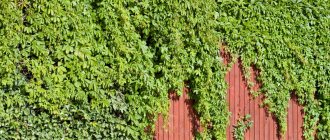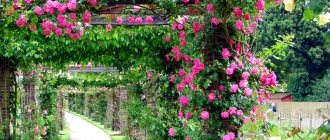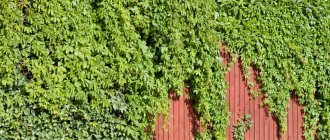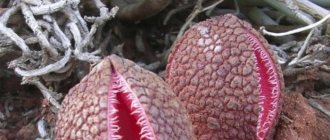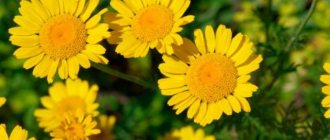It is difficult to imagine a modern summer cottage without picturesque landscape design. Overgrown decorative loaches help create flowering islands. It delights with its beauty and captivates with the brightness of its colors. Let us tell you what types of such flowering vines are actively used to create vertical gardening. Read and learn all the nuances of caring for flowering perennials.
Bright, lush design Source yandex.net
Description and features of bindweed
It is a perennial or annual herbaceous plant or shrub. It reaches a height of 4 m, has creeping or erect stems, a creeping root system with thread-like roots.
Whole, alternate leaves are located on petioles. They are arrow-shaped or heart-shaped, with teeth or divided into lobes.
The flowers are arranged singly or in inflorescences in the axils of the greenery. Their shape is funnel-shaped or bell-shaped, while the blades are weakly defined. Opens its petals in the early morning, only in clear weather.
After flowering, fruits begin to form. These are boxes containing seeds. They retain germination for 2-3 years after collection.
Types and varieties of bindweed
The genus includes 75 varieties, the identity of another 836 has not yet been precisely established. Only some species are common in Russia.
Field
Perennial or annual, reaching a length of 1-1.5 m. The flowers are small, growing along the entire smooth or fleecy stem. They come in a variety of colors: most often snow-white or pinkish, less often blue, light blue or violet. Flowering period: from the second decade of spring until frost. Reproduction occurs by seeds or root suckers.
Typically, field bindweed (ordinary) is destroyed in vegetable gardens and summer cottages, because it grows very quickly and entangles other crops, taking away their vitality. However, it also has benefits that not everyone knows about. Plants planted nearby are less likely to be affected by mold or mildew. Field bindweed also makes good mulch.
The plant also has healing properties. It perfectly helps with pathologies of the kidneys and liver, treats respiratory diseases, and cleanses the circulatory system.
Garden
A distinctive feature is the variety of contrasting and bright colors. A flowering carpet can decorate an unsightly slope on a site, an empty space or an alley. Garden bindweed is also used to decorate borders and create partitions. They can separate one part of the site from another and shade the remaining crops. Popular varieties:
| Name | Description | Flowers |
| Mauritanian | Up to 0.5 m. Usually grown in containers or hanging pots. The foliage is grayish-malachite in color. | Light lilac. |
| Double-vertex | Up to 0.4 m. In the wild, it can be found on mountain slopes, sandy shores of reservoirs, and in the steppes. Stems creeping or slightly erect. The plates are arrow-shaped, bare or pubescent. | Single, pudding. |
Tricolor
Exotic decorative vine up to 0.5 m in length. The foliage is bluish-emerald, densely planted along the entire stem. Large flowers with wavy edges reach 5 cm in circumference.
The most beautiful varieties:
- Blue and Rainbow Flash with whitish ultramarine flowers, lemon pith;
- Royal Ensign with velvety purple petals with a black tint;
- Crimson Monarch with bright raspberry buds.
Tricolor bindweed is a low-growing plant with a large number of side shoots, giving the bush the shape of a sphere. This variety looks impressive in containers on terraces, loggias, window sills, and balconies.
Growing bindweed from seeds
The flower is propagated only by seeds. They can be sown directly into an open area or planted as seedlings. Pre-growing from seeds indoors is preferable, so the bush will grow faster and bloom more profusely.
Sowing of seedlings is carried out in March:
- Leave the seeds in water for a day.
- Place in separate containers with soil mixture for flowering plants. It is not advisable to plant in common containers, because bindweed does not tolerate transplantation well.
- Deepen the seed and cover it with a thin layer of soil.
- Keep pots at +18…+20° C.
- Apply mineral fertilizers. Water regularly, not allowing the soil to dry out.
- The first shoots will sprout after a couple of weeks.
Reasons for the popularity of climbing plants
Having decided to decorate a fence on their property, many people pay attention to climbing plants and there is an explanation for this. Such a green hedge has many advantages:
- Possibility of use for zoning a garden or creating a background for a flowering lawn.
- A spectacular view and the ability to hide behind the fence everything that strangers should not see.
- Lianas require a minimum of free space. Therefore, they will be appropriate even where there is no room for trees or shrubs.
- Climbing plants perfectly retain dust from the street, purify the air, saturating it with oxygen.
Decorating a fence with a perennial climbing plant Source mrrestavrator.ru
Planting bindweed in the garden
Before planting, seedlings must be hardened off. To do this, she is taken outside every day, starting from 10 minutes, gradually increasing the time of “walks”. Thanks to this, the bindweed will have a stronger immune system and will be able to resist various diseases.
Landing dates
Planting is done after the snow melts, when the risk of frost returns disappears. This usually happens in mid-May to the first half of June.
Landing technology
It is necessary to choose a sunny place. Only in this case will it bloom magnificently and for a long time. The flower is unpretentious to soil mixtures, but grows better on a permeable, loamy substrate. Landing occurs as follows:
- Dig up an area with peat (2-3 kg per 1 sq.m).
- Level the ground surface.
- Move the plants into holes located at a distance of 20-25 cm from each other using the transfer method. Before transplanting, water the seedlings (it will be easier to remove the bushes from the pots).
- Moisten thoroughly.
Caring for bindweed
Planting and further care of the plant are simple. It is enough to fulfill some requirements:
| Criterion | Recommendations |
| Watering | Regular and plentiful. If there is a lack of moisture, the flower will drop its petals. When moisturizing, make sure that there is no stagnation of liquid. Because of this, a fungal infection may begin to develop. |
| Top dressing | If growth is slow, add wood ash or fertilizer for flowering plants. For example, Nitrophoska, Agricola. |
| Weeding | In the first 2-3 weeks after planting. When the bushes get stronger, they will be able to suppress weeds. |
| Formation | It is necessary to create a support so that the bindweed can entwine it during active growth:
When a flower grows in the wrong direction, prune it. |
After flowering
In Russia it is grown as an annual plant. Therefore, in mid-autumn it is necessary to dig it up with its rhizome and dig up the area. Since the flower has the ability to self-sow, new specimens will begin to form in the same place next season.
Rules for creating vertical gardening
Loaches are not suitable for decorating flower beds: in a short time they fill the entire space, and the module loses its shape. This makes its decorativeness disappear. Creeping, climbing, clinging plants are used to enliven fences, house facades, and gazebos. Dense planting of such specimens along the perimeter of the fence can save you from street noise and gases coming from a busy road. Whatever style of landscape design is chosen, their presence will be appropriate everywhere.
Fences tightly covered with vines Source yandex.net
In order for the plant to demonstrate all its beauty, it is important to choose the right support for it. It is necessary to remember that perennial vines do not tolerate movement well, so you will have to decide in advance how to beautifully plant the vines, how to arrange them along the vertical axis, taking into account climatic conditions and the requirements of modern agricultural technology.
Climbing plants need proper support Source dachadesign.ru
Diseases and pests
Bindweed is a robust plant that is rarely affected by disease or insects. Sometimes, in the absence of proper care, a flower gets powdery mildew. It can be identified by the following signs:
- White powdery spots containing fungal spores. After a while, they begin to secrete liquid drops that resemble dew.
- Early petal fall.
- Curling and wilting of foliage.
- Stopped development.
The disease most often occurs due to errors in care:
- high humidity;
- aphid damage;
- excess nitrogen in the soil;
- excessive planting density.
Fungal spores can also enter with water during watering or from other plants through the wind, through a person or undisinfected equipment.
If the damage is severe, the flower dies; in the initial stages of the disease, it can still be saved:
- Remove affected areas.
- Spray with soda ash (2-3 g per 1 liter of water) or soap-copper solution (25 g of green soap and 2.5 g of copper sulfate per 1 liter of liquid).
- Treat the bush itself, containers, and soil with Vitaros, Fundazol, Topaz, Hom or other fungicides.
Occasionally, aphids begin to live on bindweed. Insect pests can be recognized by the following signs:
- wilting of young leaves and buds;
- dark spots (punctures from proboscis);
- syrupy liquid on the aerial part;
- the appearance of ants near the plant (they are attracted by sticky mucus).
You can destroy the insect in the following ways:
- wipe the above-ground part with a cloth soaked in soapy water;
- purchase larvae of red ants or ladybugs at a gardening store (these are natural enemies of the pest);
- use purchased drugs: Commander, Bankol, Vertimek and others.
Morning glory - photo
Morning glories can be grown into a true flowering carpet or used to decorate arches, arbors and hedges. Watch and get inspired!
Photo: fotokto.ru
Photo: goodfon.ru
Photo: zen.yandex.ru
Photo: u-florista.ru
Photo: kingsseedsdirect.com
Photo: fotokto.ru
Photo: liveinternet.ru
Photo: vseobzorko.ru
Photo: stavropollibblind.blogspot.com
Photo: fotoload.ru
Photo: publicdomainpictures.net
Photo: photographyartplus.wordpress.com
Photo: pixabay.com
Photo: pinterest.ru
Photo: landscapetnik.com
Photo: etsy.com
Photo: szinnia.blogspot.com
Photo: flipboard.com
Photo: latin-wife.com
Photo: 1zoom.ru
Photo: dachnaya-zhizn.ru
Photo: fotokto.ru
Photo: pxhere.com
Photo: kartoska.ru
Photo: sites.google.com
Did you like the post? Subscribe to our channel in Yandex.Zen, it really helps us in our development!
Mr. Summer Resident informs: how to get rid of field bindweed
Wild bindweed can be a problem in your garden. By entwining other plants, it suffocates them and prevents them from growing normally.
A fast-growing weed should be destroyed while it is still young. It must be completely torn out without leaving roots in the ground. New shoots can begin to form from them. Collect all parts of the plant carefully so that the seeds do not scatter and burn. If this does not help, then it is advisable to use poisonous drugs: Linder and others.
To avoid unwanted growth of bindweed in the future, dig up all the soil in the spring, destroying the remaining roots. After this, cover the area with material that does not allow light and air to pass through. Under such conditions, the remaining parts of the plant will die. Green manure also helps prevent unwanted weed growth. For example, white mustard.
Briefly about the main thing
Loaches are ideal for vertical gardening; with the help of planting such plants, you can zone a site, decorate the facades of houses, mask their defects, and completely cover fences and outbuildings with a green blanket.
There are a large number of decorative species, including creeping and creeping vines. In order for everyone to reveal their beauty, it is necessary to choose the right support for it.
The rules for creating vertical gardening are extremely simple; it is important to take into account the frost resistance of loaches, its compliance with existing climatic conditions, and the growth pattern of the vine.
Gardeners necessarily include azarina, aconite, clematis, wisteria, virgin grapes and perennial morning glory in the list of the most popular loaches.
